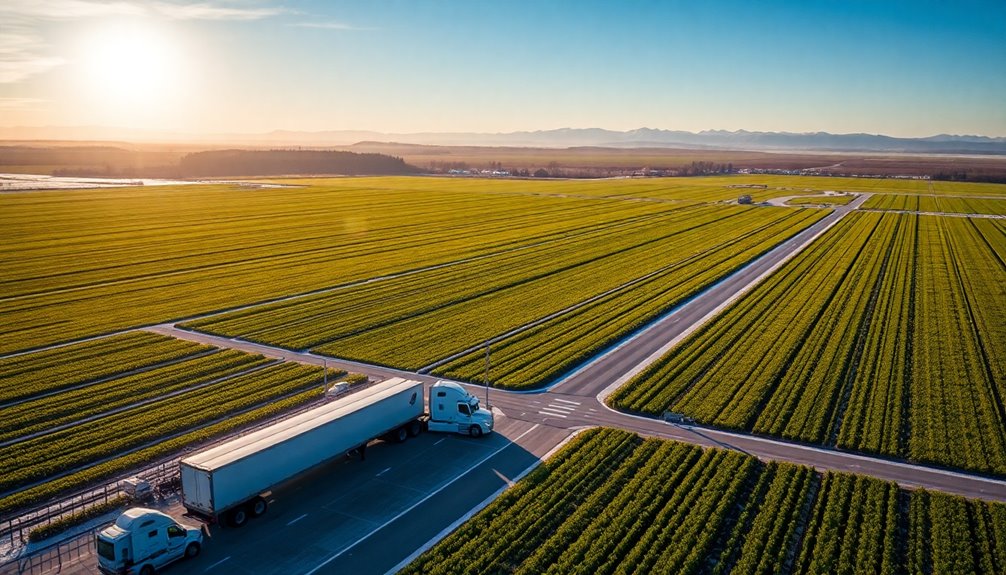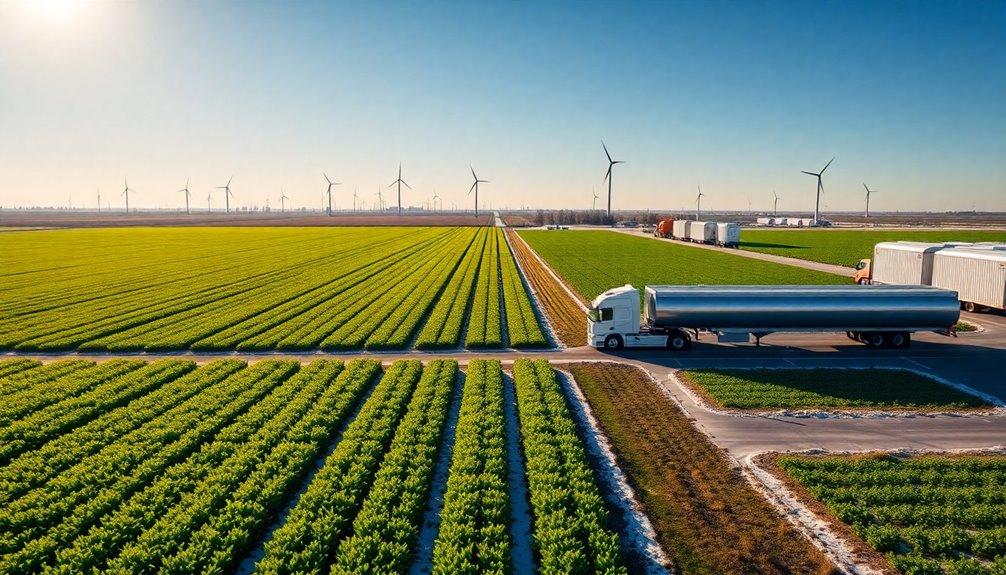To optimize supply logistics for winter oilseeds like pennycress, camelina, and carinata in sustainable aviation fuel production, focus on strategic site selection for processing facilities. Efficient transportation routes and integration into existing crop rotations can enhance resource flow and reduce costs. Utilizing meal credits can also lower production expenses significantly. Engaging local economies and sustainable agricultural practices will further support your efforts. Discover even more effective strategies to boost your operations and meet production targets.
Key Takeaways
- Strategic location planning for processing facilities minimizes transportation costs and enhances the flow of winter oilseeds like pennycress, camelina, and carinata.
- Integrating winter oilseeds into existing crop rotations improves land use efficiency and supports sustainable agricultural practices.
- Cost-effective logistics, including streamlined transportation and distribution networks, are essential for meeting the growing SAF production targets.
- Collaborating with local farmers and initiatives fosters community involvement and optimizes resource utilization for oilseed production.
- Utilizing leftover meal from oilseed processing as high-protein animal feed adds revenue streams and supports economic viability in regional agriculture.

As the demand for sustainable aviation fuel (SAF) rises, optimizing the supply logistics for winter oilseeds becomes essential for meeting ambitious production goals. The U.S. aims to produce 35 billion gallons of SAF annually by 2050, and winter oilseeds like pennycress, camelina, and carinata have the potential to contribute significantly—up to 1.12 billion gallons by 2048 if all oilseed-producing counties participate.
To achieve this, you'll need to focus on efficient supply chain management that minimizes costs while maximizing output. Strategic location planning is crucial here. By determining optimal sites for processing facilities and biorefineries, you can cut costs and ensure a smooth flow of resources.
Efficient supply chain management and strategic location planning are key to optimizing costs and resource flow in sustainable aviation fuel production.
Consider integrating winter oilseeds into existing crop rotations. This approach not only optimizes land use but also enhances soil health, allowing you to grow these crops between main harvests without needing additional land. Your involvement in initiatives like the Forever Green Initiative and the Minnesota Sustainable Aviation Fuel Hub will support regional development and bolster local economies. Oil seeds provide soil cover, protect water quality, and support wildlife habitat, making them an attractive choice for sustainable agriculture.
While current production of winter oilseeds in Minnesota is limited to about 2,000 acres, expansion plans are in motion to significantly increase this acreage, thus meeting local SAF needs. The economic viability of this endeavor hinges on reducing costs, and you can achieve this by including meal credits in your production model, potentially cutting costs by up to 70%.
Additionally, the growing demand for SAF enhances your profit margins, while the leftover meal can be sold as high-protein animal feed.
Frequently Asked Questions
What Are the Environmental Benefits of Using Winter Oilseeds in Aviation Fuel?
Using winter oilseeds for aviation fuel brings significant environmental benefits.
You'll see a reduction in greenhouse gas emissions, with some oilseeds cutting emissions by over 65% compared to traditional fuels.
These crops can be rotated with existing agricultural practices, minimizing land use changes.
Additionally, they boost soil health by enhancing organic carbon levels.
How Do Winter Oilseeds Compare to Traditional Feedstocks for Biofuels?
When you compare winter oilseeds to traditional feedstocks for biofuels, you'll notice significant advantages.
Winter oilseeds like pennycress, camelina, and carinata can reduce greenhouse gas emissions by over 50% compared to petroleum fuels. They also utilize land that would otherwise be fallow, enhancing agricultural productivity.
Additionally, their oil content and energy yields present a promising alternative, making them a more sustainable choice for biofuel production in the aviation industry.
What Are the Economic Impacts of Winter Oilseed Cultivation on Local Farmers?
The economic impacts of winter oilseed cultivation on local farmers can be significant.
You'll find that these crops can provide additional revenue streams through biodiesel production and meal credits.
While production costs vary—like $279 per acre for camelina—you can enhance profitability with government subsidies and smart crop rotation practices.
How Can Winter Oilseed Crops Improve Soil Health and Biodiversity?
Winter oilseed crops like camelina and pennycress significantly improve soil health and biodiversity.
By planting these crops, you're preventing soil erosion and enhancing soil stability with their deep root systems. They scavenge excess nutrients, reducing runoff and promoting healthier ecosystems.
Plus, these crops provide habitats for pollinators and beneficial insects, fostering greater biodiversity.
Integrating them into your rotation not only boosts soil resilience but also supports a more balanced agricultural environment.
What Technologies Are Emerging in the Processing of Winter Oilseeds for Fuel?
Emerging technologies in processing winter oilseeds for fuel include advanced oil extraction methods like solvent extraction and mechanical pressing.
You'll also find innovative bio-oil conversion techniques that turn raw oil into high-quality aviation fuels.
Additionally, genetic improvements in these crops enhance yield and climate resilience.
Fuel standardization ensures compatibility with existing infrastructure, while co-products like high-protein meal diversify agricultural use and provide economic benefits for farmers.
Conclusion
In wrapping up, optimizing the supply logistics for winter oilseeds like pennycress, camelina, and carinata isn't just a smart move—it's a game changer for sustainable aviation fuel production. By streamlining processes and enhancing efficiency, you're not only boosting productivity but also paving the way for a greener future. So, let's cultivate these opportunities and watch as our efforts take flight, transforming the skies with cleaner, sustainable fuel for generations to come.









